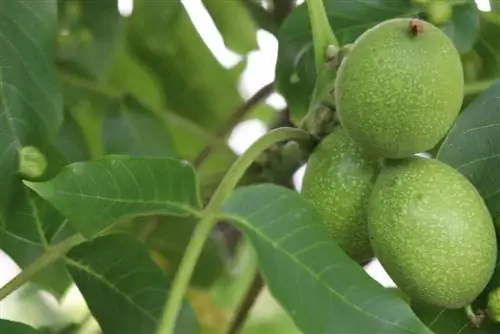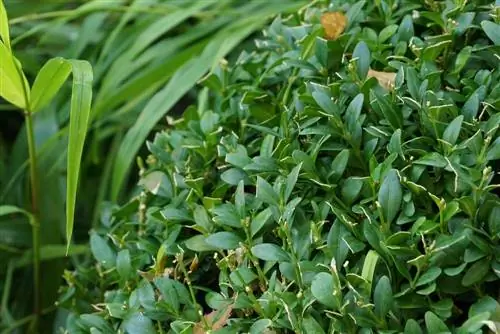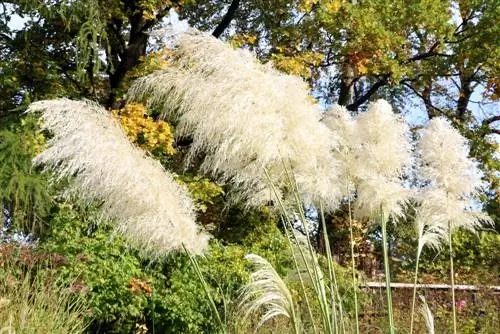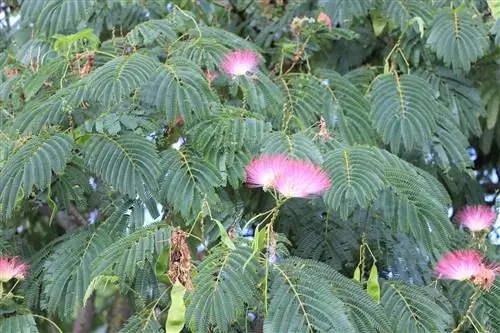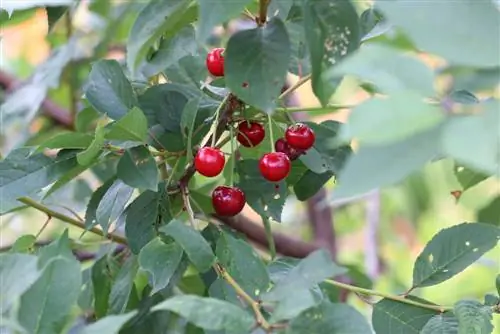- Author admin [email protected].
- Public 2023-12-17 03:39.
- Last modified 2025-01-24 12:45.
The walnut tree is popular because of its nuts, but also because of its special wood. This is often used as veneer wood. Wood is very hard and is used for floors and furniture.
Features
Walnut trees can grow to impressive sizes, 15 to 25 meters are not uncommon, some even grow up to 30 meters high. A walnut tree can live to be around 150 years old, with growth stopping approximately halfway through the years. Because of its height and the expansive circumference of the crown, this tree needs deep roots, so-called taproots. The bark of the walnut on a young tree is still smooth and slightly gray. As it gets older, the bark can not only become darker, but also be marked by deep cracks. The leaves of the walnut are alternate on the branch and are around 30 cm tall. Walnut trees are usually the last to turn green in spring and are among the first to shed their leaves in autumn. If they are crushed, they give off an aromatic, bitter smell.
- A walnut tree has both male and female flowers on one tree.
- The males sit on the hanging “kittens”, which got their name because of the soft down.
- The walnut blooms from April to June, the fruits are nuts.
- These walnuts have different shapes and sizes depending on which of the approximately 60 species they are.
Home
Their homeland is probably in Syria, western and southern Anatolia and in the Middle East and Central Asia. From there the walnut was transported to other regions, including Central Europe. The researchers are pretty sure that the Romans were heavily involved. Even though they are rarely found in the wild today, they occur in alluvial forests on the Rhine and the Danube. The real walnut is now also grown in North America, and large, very profitable plantations have been set up in California.
Location
The walnut can only find space in the garden if it is big enough. Often it sows itself randomly, ravens and crows fly to their feeding place with the nuts in their beaks, sometimes they lose one, which then becomes a seedling if the conditions are good. This would then be a wild form of the walnut; the nuts that are available commercially come from high-yield breeds.
- Basically, it takes a while for the walnut tree in the garden to bear fruit: this only happens when it is between 10 and 20 years old.
- Not every tree bears fruit, not every tree bears the same amount and not every year. The weather plays a very important role.
- A good harvest year is followed by two lean years. In general, the good year for walnuts is also said to be a good year for wine.
On farms, nut trees are usually found near cowsheds or manure heaps. The reason for this is that the walnut tree is said to have special properties. No other plants grow under a walnut tree. This is because the tree secretes substances that prevent this and are called biochemical defenses. The leaves have a particularly high amount of tannins and rot much more slowly than other leaves. Nut trees also have the ability to repel flies, which is why they are in close proximity to animals and manure.
Planting and pruning
You should only plant a walnut tree if the garden is large enough. The tree must not be placed too close to the neighbor's border; its future size may cause discord there. Even if this takes twenty or more years, the larger the tree gets, the more difficult it becomes to have to remove it later. Additionally, no other type of tree or shrub will grow near a walnut tree, especially not directly underneath it. Direct or immediate proximity to a building should also be avoided.
Tip:
Prune the walnut tree regularly to limit growth.
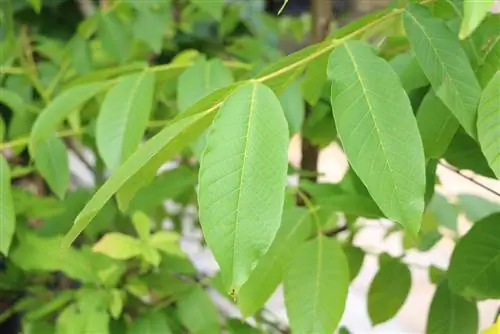
Once the walnut tree has grown in the garden, it should be pruned in the spring. The old wood can also be cut back; the older the tree, the thicker the branch that needs to be removed. If the crown is removed in later years, the walnut tree tends to grow wider. In summer, when the leaves are fully grown, you can see exactly where you could cut back. This prevents large gaps from appearing later in the overall appearance of the tree.
Training the walnut tree crown
- Since walnut trees are strong-growing trees, it makes sense to train a corresponding crown right from the start.
- Shortening side shoots is not very cheap, the action only helps in the short term.
- Better is a thinning cut in which you completely remove some of the crown branches. This creates a loose crown in a few years.
- If it is necessary to prune the trunk extension and some side branches, a derivation cut is best.
- The shoot is cut back to a weaker side shoot. This then takes over the function as tip.
- Several shoots usually form there in the coming year. All but one, the intended leader, are removed.
- If you simply remove the top of the walnut tree so that it no longer grows tall, the result is that the tree sprouts extremely heavily, usually in a broom-like manner, which is not at all desirable.
- In this case, it needs to be trimmed very often. So it's better to cut it back to a suitable weaker branch.
Pests on the walnut tree
Walnut trees have been increasingly attacked by the walnut fruit fly (Rhagoletis completa) in Europe since the 1980s. It lays eggs in the unripe pericarp of the nut, causing the fruit to rot and turn black. The pulp can no longer be removed from the nut. In years with heavy and frequent downpours and few intermediate highs, walnut trees do not dry sufficiently. This can cause leaf spot fungus (Gnomonia leptostyla, Marssonina juglandis). This fungus is capable of destroying entire crops.
What you should know in brief
A walnut tree doesn't have to be cut, but it can if you follow a few rules. Pruning is not necessary to increase yields. In principle, you only cut it when it has become too big or so that it doesn't get that big in the first place.
Cutting time
- Since the cuts heal only slowly, the right time is particularly important.
- In spring the sap pressure is very high, which is why cutting causes the tree to lose a lot of sap.
- Even if this bleeding is not life-threatening for the walnut tree, it is better not to prune so early.
- An appointment in late summer is better. The end of August to the end of September is ideal.
- The wounds can then close until the first frost.
Reduction of the crown
- Short every second shoot in the outer crown area at the level of a fork by a maximum of 1.5 meters!
- Leave the other shoots standing - they will be cut next year.
- The natural growth habit must not be impaired!
Remove regularly
- It is best to cut out shoots that grow steeply upwards and are in competition with the central shoot or leading branches in the year they are created.
- They are cut out at the attachment point.
- This is the only way an even crown can form.
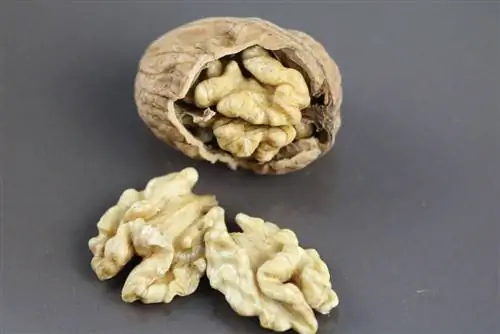
Conclusion
If you want to plant a walnut tree, you should choose a refined variety. These trees don't grow quite as tall or voluminous. In addition, you should not plant a walnut tree too close to the property line to avoid later disputes. You can train a young tree quite well so that you don't have to make radical cuts later. It's better to cut a little from the start, it's much better for the tree.

